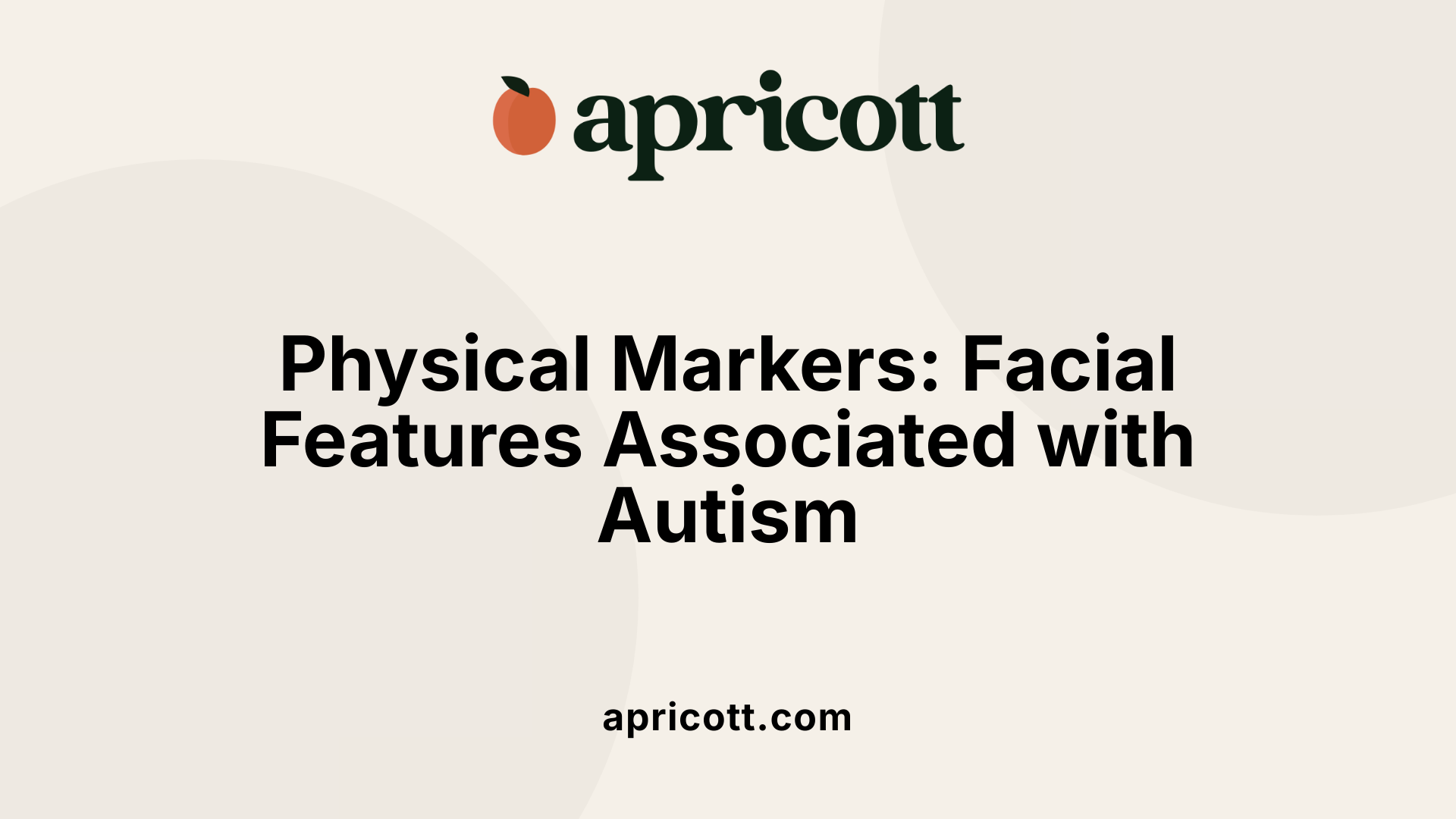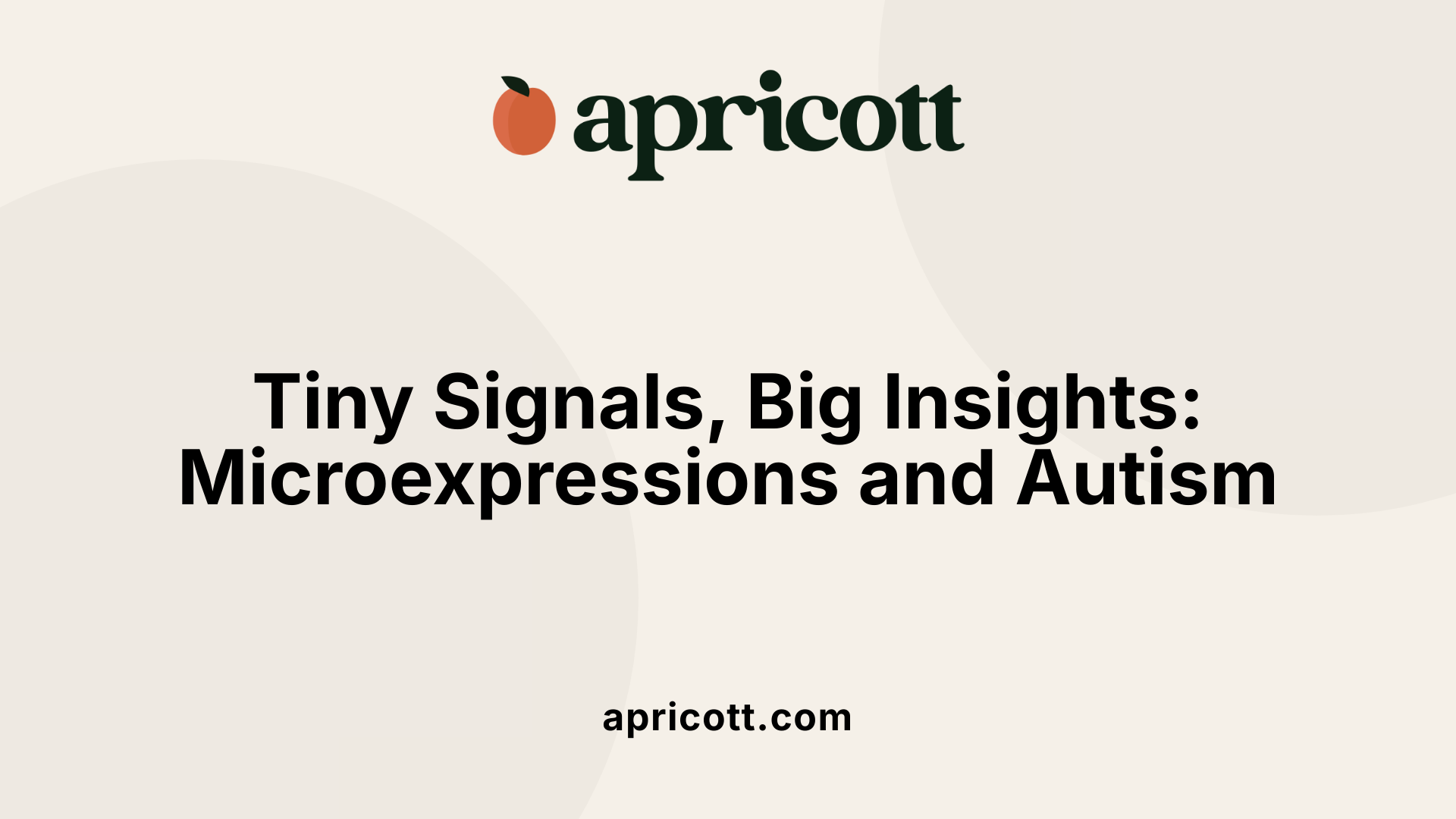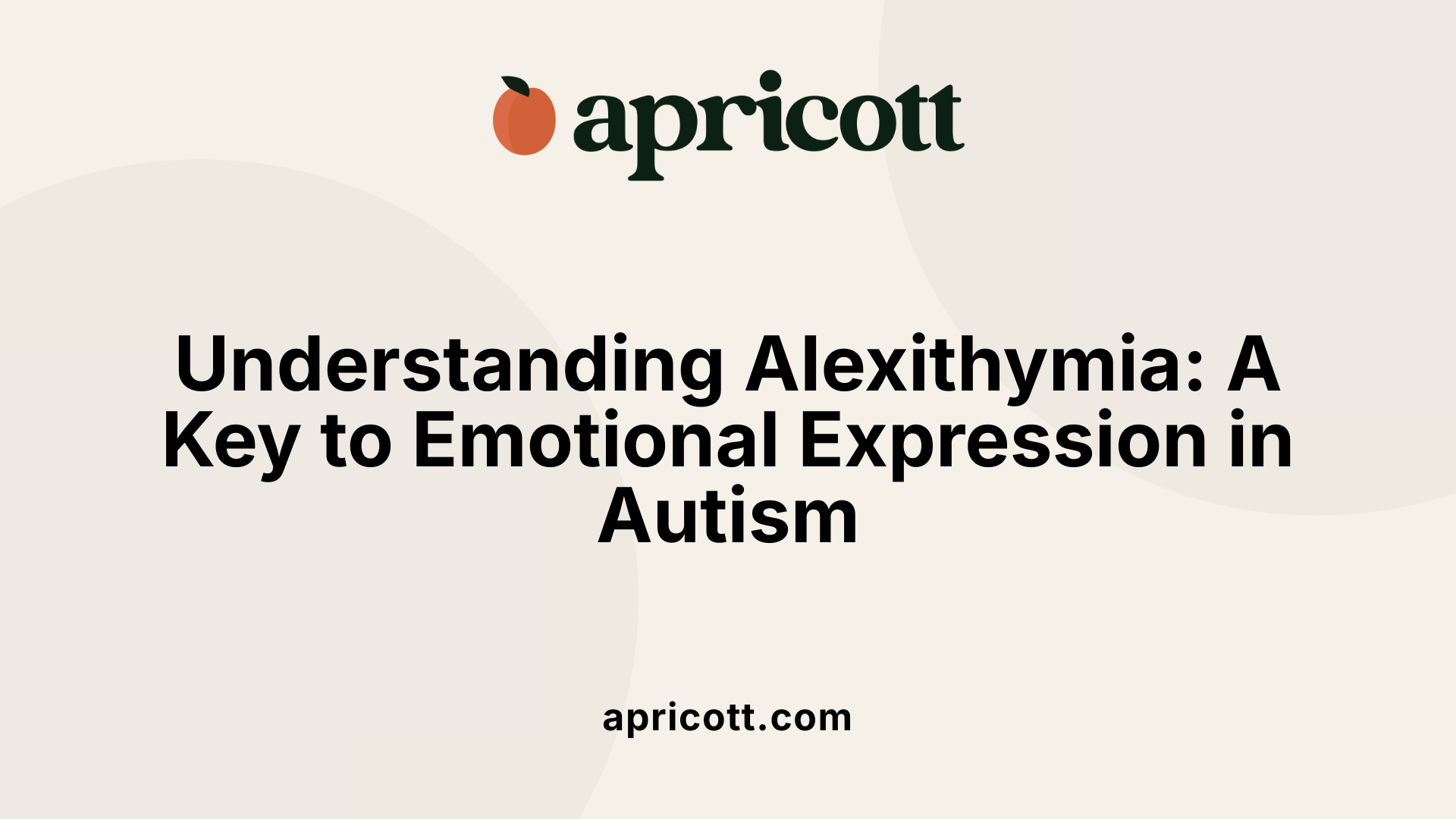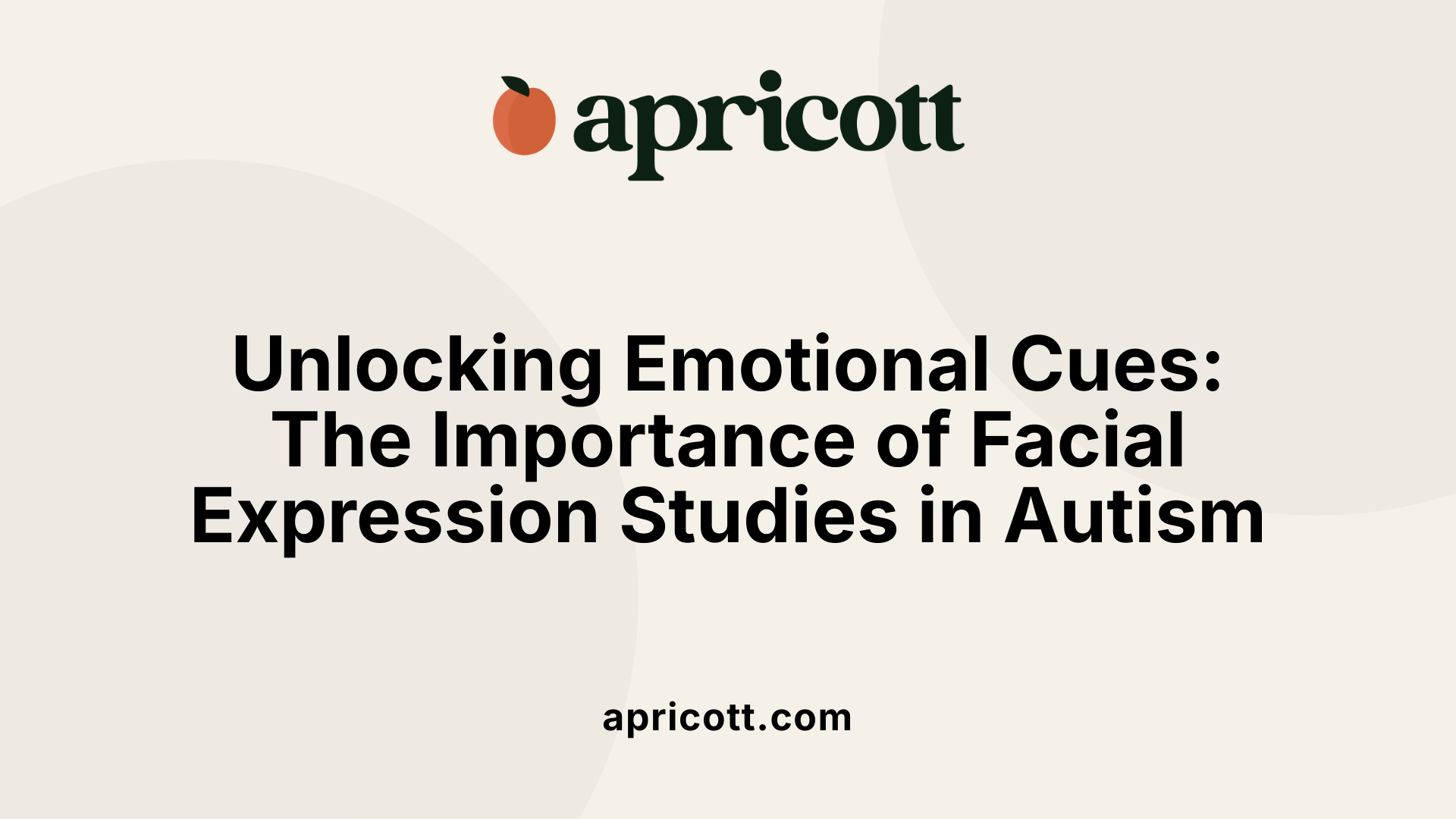July 22, 2025
Deciphering the Subtle Language of Autism through Facial Cues
Facial expressions serve as vital indicators of emotional states and are fundamental to human social interactions. In autism spectrum disorder (ASD), these expressions often diverge from typical patterns, affecting communication and social understanding. This article delves into the physical features associated with autism, the nature of facial expressions in autistic individuals, their recognition and interpretation challenges, and emerging research and technological advances that aim to shed light on this nuanced aspect of autism.

Children with autism often display specific facial features that are linked to underlying embryological brain abnormalities. These traits include a broader upper face, which gives the face a wider appearance across the forehead and upper region. Additionally, they tend to have wider-set eyes, a condition known as hypertelorism, which can contribute to a distinctive facial appearance.
Another common feature is a shorter middle face region that encompasses the cheeks and the nose, leading to certain facial proportions that differ from neurotypical development. Many children with autism also have a broader mouth and a longer philtrum, the vertical groove situated below the nose and above the top lip.
Studies using advanced 3D mapping systems have revealed these characteristics, which may be visually subtle but are associated with neurological issues linked to autism. These facial dysmorphologies often correlate with the severity of autistic symptoms and can serve as potential biomarkers for early detection.
Other observed features include increased distance between the inner corners of the eyes (intercanthal distance) and some degree of facial asymmetry or variations in facial masculinity. While these traits don't serve as standalone diagnostic markers, they contribute valuable clues in understanding the physical underpinnings of autism.
Research suggests that these facial traits, when studied in conjunction with other signs, can assist in early risk assessment. The goal is to recognize structural differences that might reflect early developmental disturbances associated with autism.
However, it is important to emphasize that facial features alone are not diagnostic of autism, as there is significant variation among individuals. They should be considered supplementary indicators, aiding healthcare professionals in early screening alongside behavioral and neurological assessments.
In summary, distinctive facial features linked to autism serve as important clues for early detection and deepen our understanding of the condition’s developmental origins. Advances in 3D imaging and analysis continue to refine how these physical markers are identified and utilized in research and clinical practice.
Individuals with autism often display unique patterns of facial expressions that can make social interactions challenging. They tend to show less spontaneous facial expressiveness, which means their facial reactions are fewer and often brief. This can lead to difficulties in conveying their emotions clearly to others.
Research indicates that autistic individuals produce emotions such as smiles and frowns with similar intensity and duration as neurotypical people. Quickly responding to stimuli with facial expressions shows that their basic ability to produce these expressions is present. However, the way they use their faces in social settings may differ.
Many autistic people have trouble making appropriate facial expressions that match the situation. For example, they might remain expressionless or produce looks that are difficult for others to interpret. This includes less eye contact, gaze avoidance, and reduced mimicry of others' facial cues, which are essential for social bonding.
In some cases, expressions can seem exaggerated, overly intense, or unusual. This variability in expression can sometimes be perceived as insincere or unnatural, which may contribute to social misunderstandings. Interestingly, adults with autism often misinterpret facial cues; they tend to see neutral faces as negative or attribute emotions that aren’t there.
While the facial muscles used are the same, the subtlety, timing, and recognition of emotional expressions often differ. Variations tend to lessen with age and higher IQ levels, suggesting that some individuals develop compensatory strategies to navigate social situations more effectively.
Overall, common facial expressions in autism reveal a complex picture—showing that while the capacity for emotional expression exists, the way it manifests in everyday interactions can differ markedly from neurotypical expectations.
| Aspect | Observation | Additional Details |
|---|---|---|
| Spontaneous expressions | Less frequent, often fleeting | Reduced non-verbal cues hinder social understanding |
| Intensity of expressions | Similar variations as controls for smiles and frowns | Recognizable but sometimes exaggerated or intense |
| Matching expressions | Difficulty aligning facial expressions with social context | Results in perceptions of unnatural or inappropriate expressions |
| Recognition and mimicry | Less mimicry and synchronization during social interactions | Impacts bonding and social skills |
| Changes with age & IQ | Older and higher IQ individuals show smaller differences | Suggests development and adaptive strategies |
Understanding these facial expression patterns is crucial for developing targeted interventions that improve social communication skills in autistic individuals.

Autistic individuals often face difficulties in recognizing and interpreting facial expressions, especially those that are subtle, brief, or less intense. Studies show they tend to perform worse than neurotypical controls when identifying emotions like anger, fear, or happiness. While neurotypical individuals generally improve their emotion recognition as they grow older, autistic individuals often do not experience the same level of progress, leading to ongoing challenges.
Recent technological advances, including analysis of tiny facial microexpressions, shed light on these issues. Rutgers-led research found that autistic people produce the same basic facial movements to express emotions as others do, but their microexpressions are often too subtle or atypical for observers to notice. This affects their ability to communicate emotions effectively and interpret others’ facial cues.
Autistic faces can sometimes seem overly intense or unusual, even when emotions are genuinely expressed. They might produce longer-lasting emotional expressions and tend to misread neutral or ambiguous faces, often attributing negative emotions where none exist. These recognition and interpretative hurdles influence social interactions, leading to misunderstandings and social withdrawal.
Autistic individuals exhibit biases in perceiving emotions, notably over-attributing negativity to neutral faces. For example, research shows they are more likely to interpret neutral expressions as negative, which can create challenges in social exchanges. Moreover, their perception can be heavily influenced by body language and context, often more so than in neurotypical individuals.
In some cases, this leads to a negative bias—overestimating or misinterpreting emotions—which can make social interactions taxing or stressful. Such biases are associated with reduced social skills and impaired emotional intelligence, further impacting social engagement and understanding.
Recognizing neutral or ambiguous expressions is notably difficult for autistic people. They tend to interpret neutral faces as negative and often struggle to distinguish positive emotions from neutrality. This tendency can distort their view of social cues, making it more challenging to interpret interactions accurately.
Research indicates that errors in recognizing facial emotions are linked to greater difficulties in social communication. These perception issues may stem from reduced precision in processing facial cues, leading autistic individuals to rely more heavily on contextual clues like body posture, which can bias their judgments.
The recognition challenges and perceptual biases significantly affect how autistic individuals engage socially. They are less likely to smile appropriately or synchronize facial expressions with conversation partners. This reduced mimicry and facial responsiveness can hinder social bonding.
In conversation, autistic individuals often display less facial mirroring or matching, which are unconscious behaviors that help foster connection. Difficulties in facial expression synchronization correlate with poorer social skills and empathy, complicating both personal and professional relationships.
| Aspect | Typical Development | Autism Spectrum Disorder | Impact |
|---|---|---|---|
| Facial expression recognition | Usually improves with age; highly accurate | Often impaired; less accurate, especially for subtle expressions | Less effective social communication and increased misunderstandings |
| Interpretation of neutral faces | Usually accurate; neutral perceived neutrally | Often interpreted negatively; neutral seen as negative or threatening | Increased social anxiety; misjudgments in social contexts |
| Microexpressions | Subtle micro-movements detected easily | Microexpressions are often too subtle or atypical to recognize | Reduced social cue detection, affecting emotional understanding |
| Response synchronization | Mimicry and mirroring common | Less mimicry; less facial synchronization during social interactions | Decreased social bonding efforts, leading to social withdrawal |
| Biases in perception | Less biased; more accurate interpretations | Tend to attribute negative feelings to neutral or ambiguous faces | Increased social misunderstandings and emotional misinterpretations |
Understanding these perceptual and interpretative patterns highlights the importance of tailored approaches in supporting social skills development in autistic individuals. Technologies like AI-powered facial analysis and microexpression detection are promising tools that could improve diagnosis and foster better social understanding.

Recent advances in technology have opened new avenues for understanding the facial expressions of individuals with autism. Researchers at Rutgers have developed a novel data type called micromovement spikes, which captures tiny facial movements often invisible to the naked eye. By recording short videos, scientists analyze these micro-movements during emotional expressions, revealing differences that are subtle but significant.
This approach allows for a detailed examination of how emotions are expressed through microexpressions. It uncovers variations in the intensity and duration of facial movements between autistic and neurotypical individuals, providing a clearer picture of emotional communication.
AI-powered tools and machine learning algorithms are now being tailored to identify microexpressions automatically. Using accessible devices like smartphone cameras, these technologies can analyze facial micro-movements in real time. Such tools promise to enhance diagnostics, especially for those with limited speech or motor control, by detecting emotional cues that are otherwise hard to observe.
Research suggests that these AI systems can differentiate subtle expression patterns associated with autism, making it easier for clinicians and families to understand emotional states and social cues, improving interaction quality.
Studies indicate that autistic individuals produce facial microexpressions that are both less intense and less spontaneous than those of neurotypical people. These micro-movements, termed microexpressions, are quick, involuntary facial expressions that reveal genuine emotions.
In autism, these microexpressions tend to be too subtle for humans to notice, often not aligning with the actual emotional experience. Longer-lasting expressions are also common among autistic individuals, which may contribute to perceptions of exaggerated or unnatural emotional cues.
Understanding microexpressions provides valuable insights into emotional processing in autism. It suggests that many perceived social difficulties are linked to the recognition and production of these subtle cues rather than a lack of emotion.
Implementing AI-driven detection tools could streamline diagnosis and help tailor interventions. For example, teaching autistic individuals to recognize and produce more typical microexpressions might improve social understanding and reduce misunderstandings.
Furthermore, these insights could support the development of communication aids that interpret microexpressions, helping autistic individuals express emotions more effectively and recognize others’ feelings more accurately.
| Aspect | Findings | Potential Benefits |
|---|---|---|
| Microexpression detection | Subtle, often invisible micro-movements reveal underlying emotions | Better diagnosis and personalized support |
| Technological tools | Use of AI and smartphone cameras for real-time analysis | Accessible, scalable assessments |
| Expression differences | Less intensity, spontaneity, and naturalness | Improved social interaction strategies |
| Impact on social communication | Difficulties in mimicking and responding to facial cues | Targeted interventions and teaching |
By exploring these tiny facial signals and harnessing technological advancements, researchers and clinicians aim to bridge gaps in social communication for individuals with autism. This ongoing work holds promise for more nuanced understanding and support, promoting more effective social interactions.

Alexithymia is a psychological trait characterized by difficulties in recognizing, describing, and processing one’s own emotions. People with high levels of alexithymia often struggle to identify what they are feeling or to communicate their emotional states effectively. This trait is common in many individuals on the autism spectrum and can influence how they express emotions through facial expressions.
Research shows that higher levels of alexithymia are associated with reduced expression of negative emotions, such as sadness or anger, in facial cues. Conversely, individuals with elevated alexithymic traits tend to display more neutral facial expressions, even when they experience strong emotions. This can make it difficult for others to interpret their internal emotional states accurately.
Studies reveal a negative correlation between alexithymia and the production of negative facial expressions (r = -0.37). Higher alexithymia also correlates with more neutral facial expressions (r = 0.43). In children with ASD, these tendencies are even more pronounced, with alexithymic traits explaining about 34.6% of the variation in how facial expressions are produced, surpassing the influence of autistic traits alone.
Researchers utilize standard instruments like the Children’s Alexithymia Measure (CAM) to evaluate levels of alexithymic traits in children with ASD. These assessments help distinguish between emotional expression deficits caused by autism itself versus those related to alexithymia. Elevated scores on such measures suggest that difficulties in emotional communication are partly due to these underlying traits.
Understanding the impact of alexithymia offers valuable insights into the social and emotional challenges faced by autistic individuals. It explains why some may appear emotionally flat or insensitive, not due to a lack of feeling but because of their difficulty in recognizing and expressing emotions. By targeting alexithymia in interventions, practitioners can develop strategies to improve emotional awareness and facial expressiveness, fostering better social interactions.
| Aspect | Description | Impact on Autism |
|---|---|---|
| Definition | Difficulty recognizing and describing emotions | Contributes to atypical facial expressions |
| Influence on expressiveness | Reduced negative expressions, increased neutrality | Affects social communication |
| Assessment tools | CAM and similar measures | Identifies severity of alexithymia |
| Implications for intervention | Focus on emotional awareness and expression training | Enhances social understanding and skills |
Overall, acknowledging the role of alexithymia clarifies why facial expressions in autism can be unconventional and how addressing it may improve social and emotional functioning.
Research shows noticeable differences in facial expressions among autistic individuals depending on their age and intelligence quotient (IQ). Older individuals with autism and those with higher IQs tend to display facial expressions that are closer to those of neurotypical controls. This reduction in differences is often attributed to the use of compensatory strategies learned over time.
Younger children and individuals with lower IQs typically exhibit more obvious disparities. They may produce emotion expressions that last longer, especially positive ones, and show less unconscious mimicry during social interactions. These differences can make their facial cues less recognizable and harder to interpret accurately.
As autistic individuals age, they often develop new techniques to modulate their facial expressions, which can make their emotional states appear more typical to observers. This gradual adaptation may improve their ability to engage socially and communicate emotions more effectively.
Understanding how facial expression patterns evolve with age and cognitive ability is essential for developing targeted interventions. Such strategies can help enhance social skills and emotional understanding tailored to different stages of development and IQ levels.
Below is a summary table illustrating these variations:
| Age Group | Typical Expression Traits | Variations in Autism | Possible Improvements |
|---|---|---|---|
| Children | Pronounced expressions, mimicry | Longer duration of expressions, less mimicry | Development of social copying strategies |
| Adolescents | Developing subtlety in expressions | Slight reduction in differences, more natural | Learning emotional regulation |
| Adults | More typical, influenced by experience | Smaller differences, compensatory tactics evident | Better adaptation and social engagement |
This developmental trajectory underscores how facial behaviors are not static and can evolve significantly over time. Recognizing these changes helps in designing age-appropriate, effective support that addresses the unique needs of individuals with autism at various life stages.
Recent developments in technology are opening new frontiers in understanding and assisting emotional communication in autistic individuals. Among these, artificial intelligence (AI) and machine learning tools are at the forefront. Researchers are creating sophisticated algorithms that analyze facial microexpressions—tiny, often subconscious facial movements—that are difficult for the human eye to detect.
These tools can process short video recordings of facial reactions, capturing detailed data about micro-movement spikes. By analyzing this data, scientists can better understand how autistic individuals express emotions internally versus externally, and how these expressions are perceived by others.
A variety of applications are emerging, including smartphone-based emotion recognition apps. These accessible tools can provide real-time feedback to users about their facial expressions, helping them navigate social interactions more effectively. Caregivers and therapists can also use these technologies to recognize emotions more accurately and tailor interventions accordingly.
The potential of these innovations extends beyond support; they also promise improvements in early diagnosis. By detecting subtle differences in facial microexpressions or morphology, AI systems could identify early signs of autism with greater precision. This could lead to earlier, more targeted interventions, improving social communication skills over time.
Additionally, integrating these technologies into social skills training programs can significantly enhance learning outcomes. For instance, virtual reality environments equipped with emotion recognition AI can simulate realistic social scenarios, allowing individuals with autism to practice appropriate facial expressions and responses safely.
| Technology | Application | Benefits | Challenges |
|---|---|---|---|
| AI & Machine Learning | Microexpression detection | Better understanding of emotional expression | Data privacy concerns |
| Smartphone Apps | Real-time emotion feedback | Improved self-awareness | Accessibility issues |
| Diagnostic Tools | Early detection of autism signs | Early intervention potential | Need for high accuracy |
| Virtual Reality | Social scenario training | Safe practice environment | Cost and technological barriers |
In conclusion, AI and machine learning are transforming how researchers study and support facial expression recognition in autism. These tools offer promising avenues for early diagnosis, personalized therapy, and enhanced social interactions, paving the way for more inclusive communication.
Facial expressions are critical for smooth communication and social bonding. In autism, individuals often produce facial expressions that are less frequent, more fleeting, or harder to interpret. They may also demonstrate reduced mimicry and synchronization during conversations, which are natural behaviors seen in typical social interactions.
Research indicates that autistic individuals tend to smile or respond with facial cues less often and do so less in sync with their conversation partners. This lack of synchronization can lead to difficulties in conveying emotions effectively and understanding others' feelings, impairing mutual empathy.
For instance, a study involving conversations between autistic individuals and their partners found less smiling, fewer facial matches, and weaker mimicry compared to typical interactions. Such the reduced mimicry isn't just a social quirk; it hampers the emotional resonance necessary for forming bonds.
When facial expressions do not match or follow social cues, others may perceive autistic individuals as disinterested, aloof, or confused. This misinterpretation can cause social misunderstandings and increase feelings of social isolation for autistic individuals.
Furthermore, these challenges in expressive consistency can lead to a feedback loop; difficulty in expressing emotions naturally reduces social engagement, which in turn hampers experience and skill development in social contexts. Consequently, these facial expression abnormalities significantly impact social participation and relationship building.
Interventions aimed at improving facial expressiveness and synchronization may enhance social interactions. Techniques like focusing on interests, providing visual feedback, or using technology-assisted assessments can support autistic individuals in developing more natural social facial cues.
| Aspect | Impact | Description |
|---|---|---|
| Reduced mimicry | Less emotional resonance | Difficulties in mirroring others' expressions hinder mutual understanding |
| Less synchronization | Disrupted conversational flow | Chaotic facial responses affect social bonding |
| Misinterpretation | Social misunderstandings | Atypical expressions perceived as disinterest or confusion |
| Social withdrawal | Less participation | Reduced engagement due to expressive challenges |
Understanding these factors highlights the importance of tailored interventions to improve facial expressiveness, fostering better social connections and reducing misunderstandings.

Understanding how autistic individuals express and perceive emotions through facial expressions is vital for many reasons. Although autistic people can experience rich emotional lives, their facial expressions often differ from neurotypical individuals, making social interactions more challenging.
Research shows that autistic individuals tend to produce fewer, less spontaneous, and more fleeting facial expressions. They might also exaggerate or display emotions that seem too intense or unusual to others. This can make it harder for neurotypical observers to accurately interpret their feelings, leading to social misunderstandings.
Studying facial expressions helps us better grasp the emotional experiences of autistic individuals. It reveals that their emotions are authentic and often similar in intensity to those of others. For example, studies indicate that autistic adults can produce smiles and frowns of comparable strength to their neurotypical peers, and they respond quickly to emotional stimuli.
More advanced approaches, such as analyzing microexpressions—tiny facial movements often unnoticed by the human eye—are opening new doors. Rutgers-led research using machine learning and AI-powered tools can detect these micro-movements, providing insights into genuine emotional expressions even when the face appears neutral or less expressive.
This research has practical implications. Better understanding of facial expression differences can lead to improved social skills training, helping autistic individuals develop more effective communication strategies. It can also guide interventions focused on recognizing and interpreting facial cues, which are key elements of social interaction.
Furthermore, analyzing facial morphology—like wider upper faces, broader mouths, or different face proportions—helps identify biomarkers associated with autism. Such features, although subtle, can support earlier diagnosis and better understanding of the neurodevelopmental profile.
Advances in diagnostic techniques are also a benefit of this research. Identifying microexpressions, facial structure patterns, and emotion recognition deficits may allow clinicians to develop more accurate tools for early identification of autism, ideally leading to earlier support and intervention.
Finally, understanding facial expression processing encourages the creation of targeted therapies. For example, strategies that focus on emotion recognition, social mimicry, or controlling microexpressions could improve social adaptation, reduce miscommunications, and foster meaningful social bonds.
As technology and research methods evolve, the exploration of facial expressions in autism continues to shed light on the emotional worlds of autistic individuals. This progress supports a more nuanced and compassionate approach to autism, emphasizing strengths and enabling better social integration.
Understanding and interpreting facial expressions in autism is a complex yet vital component in unraveling the social and emotional landscape of the disorder. Advances in research, from detailed morphologic analysis to microexpression detection with cutting-edge technology, are shedding new light on the emotional richness and communicative challenges faced by autistic individuals. Recognizing the unique facial feature patterns, deciphering microexpressions, and appreciating the role of alexithymia are key steps toward more accurate diagnosis, personalized interventions, and ultimately, improved social connection. As ongoing studies continue to refine our understanding, the potential for technology-assisted communication and early detection grows, opening promising avenues for enhancing the social lives of those with autism.